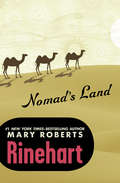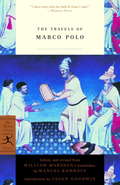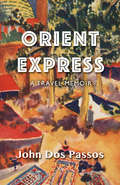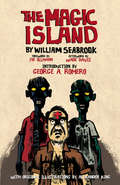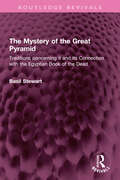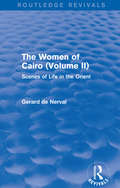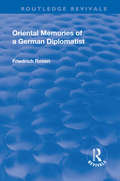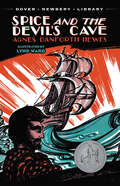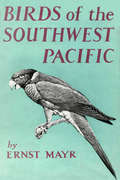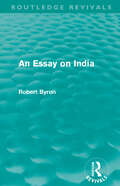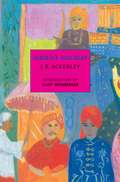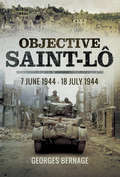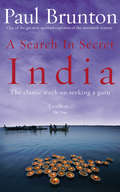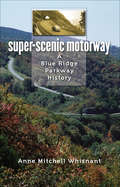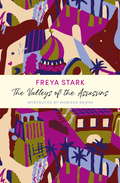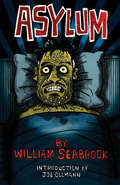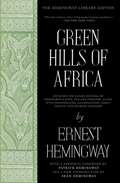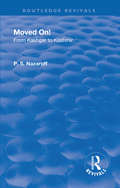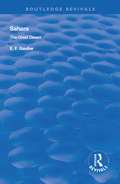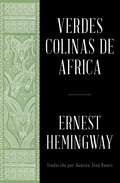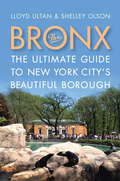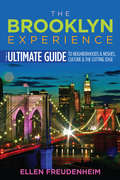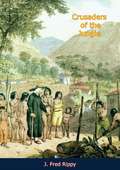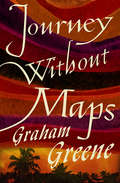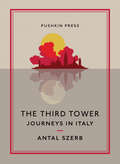- Table View
- List View
Nomad's Land
by Mary Roberts RinehartA memoir of desert travel—by camel and horseback—from a beloved authorAn internationally renowned writer of mystery fiction, Mary Roberts Rinehart knows her way around an exotic setting. When faced with the Pyramids, the Nile, and the sprawling Egyptian desert in her own life, she does not fall in with the crowd of tourists waiting in line at the tombs of the Pharaohs. Instead, she hikes up her skirt, plants her pumps in the sand, and hops on a camel. She has but one question: Where am I supposed to sit?On a hundred-mile expedition into the Egyptian desert, Rinehart does her best to master the herky-jerk of this desert beast. But traveling with an entourage of well-mannered people, she finds that desert living is not completely stripped of the comforts of home. Upon returning to the United States, Rinehart makes an excursion out west, which, she finds, is where the true adventure begins.
The Travels of Marco Polo
by Manuel Komroff William Marsden Marco Polo Jason GoodwinMarco Polo's account of his journey throughout the East in the thirteenth century was one of the earliest European travel narratives, and it remains the most important. The merchant-traveler from Venice, the first to cross the entire continent of Asia, provided us with accurate descriptions of life in China, Tibet, India, and a hundred other lands, and recorded customs, natural history, strange sights, historical legends, and much more. From the dazzling courts of Kublai Khan to the perilous deserts of Persia, no book contains a richer magazine of marvels than the Travels.This edition, selected and edited by the great scholar Manuel Komroff, also features the classic and stylistically brilliant Marsden translation, revised and corrected, as well as Komroff's Introduction to the 1926 edition.
Orient Express
by John Dos PassosBefore John Dos Passos enjoys fame as a chronicler and critic of American society, he wins recognition for command of aesthetics. Orient Express, a memoir of the author's travels through Eastern Europe, the Near East, and the Middle East, focuses on sights, sounds, and smells rather than plot or character. Dos Passos applies his instincts as a painter to mountain ranges and grimy alleyways, finding beauty everywhere. His tour extends from Tiflis, Georgia, to Erivan, Armenia, and Marrakesh, Morocco; from Kasvin, Iran, to Baghdad, Iraq, and Damascus, Syria. He crosses the Syrian Desert, observes the aftermath of the Greek-Turkish War, climbs the Caucasus, explores Persia during the rise of Reza Kahn, and records the creation of Iraq by the British. His message is clear and relevant to contemporary travelers: holiness and happiness abounds in the East as much as the West. "With the name of Allah for all baggage," Dos Passos writes, "you could travel from the Great Wall of China to the Niger and be fairly sure of food, and often of money, if only you were ready to touch your forehead in the dust five times a day and put away self and the glamorous West. And yet," he adds, "the West is conquering."
The Magic Island
by William Seabrook George A. Romero Joe Ollmann Alexander King"The best and most thrilling book of exploration that we have ever read ... [an] immensely important book." -- New York Evening Post"A series of excellent stories about one of the most interesting corners of the American world, told by a keen and sensitive person who knows how to write." -- American Journal of Sociology"It can be said of many travelers that they have traveled widely. Of Mr. Seabrook a much finer thing may be said -- he has traveled deeply." -- The New York Times Book ReviewThis fascinating book, first published in 1929, offers firsthand accounts of Haitian voodoo and witchcraft rituals. Journalist and adventurer William Seabrook introduced the concept of the walking dead - zombies - to the West with his illustrated travelogue. He relates his experiences with the voodoo priestess who initiated him into the religion's rituals, from soul transference to resurrection. In addition to twenty evocative line drawings by Alexander King, this edition features a new Foreword by cartoonist and graphic novelist Joe Ollmann, a new Introduction by George A. Romero, legendary director of Night of the Living Dead, and a new Afterword by Wade Davis, Explorer in Residence at the National Geographic Society.
The Mystery of the Great Pyramid: Traditions concerning it and its Connection with the Egyptian Book of the Dead (Routledge Revivals)
by Basil StewartFirst published in 1929, The Mystery of the Great Pyramid attempts to unravel the secrets of the Great Pyramid by drawing parallels with the rituals in the Book of the Dead. The conception of the Pyramid and the origin of the cult of Osiris and of the Book of the Dead are to be found in a common source, which maybe expressed in the one word, Messianism. The author argues that this is why the literature of early Christian gnosticism abounds in mystical pyramid figures and associated astronomical conceptions and constellations. This book will be of interest to students of history, philosophy, and theology.
The Women of Cairo: Scenes of Life in the Orient (Routledge Revivals)
by Gerard De NervalThe Women of Cairo: Scenes of Life in the Orient, first published in 1929, describes the trip to Egypt and other locations in the Ottoman Empire taken by French Romanticist Gerard de Nerval. The book focuses on both reinforcing and dispelling the old ways in which people saw the Orient, as well as examining their old and new customs. This book is perfect for those studying history and travel.
Revival: Oriental Memories of a German Diplomatist (Routledge Revivals)
by Friedrich RosenHis Excellency Dr. Friedrich Rosen, the well known German Diplomatist and Orientalist, has written a fascinating account of his manifold experiences in the Near East, including Palestine, Syria, Persia and Mesopotamia, during a period of forty years. Many politically important or otherwise interesting mean and women, such as Ex-Emperor William II, Prince Bulow, Baron von Holstein, Sir Frank Lascelles, Sir Valentine Chirol, Lord Curzon and Miss Gertrude Bell, are spoken of in this volume.
Spice and the Devil's Cave
by Agnes Danforth HewesFerdinand Magellan, Vasco da Gama, and other fifteenth-century adventurers spring to life in this thrilling tale of the competition between Portugal and the Venetian Republic to discover an all-sea trade route leading to the spices of India. In the Lisbon workshop of banker and navigation enthusiast Abel Zakuto, a group of intrepid explorers gather to discuss the possibility of finding a way around the stormy tip of Africa — the Devil's Cave. Author Agnes Danforth Hewes won the first of her three Newbery Honor awards with this book, which was praised by The New York Times as "one of those engrossing works of historical fiction whose appeal is nearly universal . . . a colorful history of a far-reaching commercial struggle and a vivid drama of individual hopes and aspirations." Enchanting woodcuts by Lynd Ward illustrate this gripping adventure, which is suitable for grades 7 and up and will delight readers of all ages.
Birds of the Southwest Pacific
by Ernst MayrThis is the only book in the English language on the birds of the wide area between Fiji, New Caledonia and Micronesia. This practical handbook, by an acknowledged authority, intended primarily for the field student, tells him how to identify and name the birds which he encounters, and what kinds of birds he can expect to find on each island. There is also a condensed summary of the presentknowledge of distribution, geographical variation and habits. Whenever feasible, keys have been supplied to facilitate identification. These keys are simplyand clearly worked out for the beginner who may not know the difference between a curlew and a godwit, or a triller and a graybird.Three magnificent color plates show 39 species which include at least one representation of all of the prominent bird families of the southwest Pacific.A series of black and white drawings show additional species. These pictureswill be particularly valuable to bird students who have never seen awood swallow, a flower pecker, a white-eye or a triller.
An Essay on India (Routledge Revivals)
by Robert ByronFirst published in 1931, Robert Byron’s Essay on India evaluates the state of colonial rule in India and analyses the contemporary problems facing the country. Based upon Byron’s travelling experiences within India in 1929 as a correspondent for the Daily Express, the work explores political factors more fully than in Byron's earlier writings, evaluating the successes and failures of British colonialism in the region.
Hindoo Holiday
by J. R. Ackerley Eliot WeinbergerIn the 1920s, the young J. R. Ackerley spent several months in India as the personal secretary to the maharajah of a small Indian principality. In his journals, Ackerley recorded the Maharajah's fantastically eccentric habits and riddling conversations, and the odd shambling day-to-day life of his court. Hindoo Holiday is an intimate and very funny account of an exceedingly strange place, and one of the masterpieces of twentieth-century travel literature.
Objective Saint-Lô: 7 June 1944–18 July 1944
by Georges Bernage&“A collection of eyewitness accounts of the heavy fighting that took place in this part of France after the Omaha landings . . . excellent and gripping.&”—FSAddon This book provides a day-by-day account of the forty-two days of fighting from Omaha Beach to Saint-Lô. Follow Lt. Allsup from the beaches at Hill 108 (the &“bloody hill&”), where he was injured, and Lt. Jones, who was among the first to enter Saint-Lô; a town destroyed by bombs, which was to become the graveyard of hundreds of Normans. On the opposing side, discover the fate of the fearsome &“green devil&” paratroopers of General Schimpf and follow in the footsteps of paratroopers Erwin Schmieger and Rudi Frühbeisser, as they defend their armed camp, ensuring that every hedge will only be taken at the highest price. Objective Saint-Lô takes the reader along the little or unknown routes from the horrors of Omaha Beach to Trvires, La Cambe, Isigny, through the Aure valley to Hill 108, (&“Purple Heart Hill&”) and Hills 192 and 122. As well as authentic eyewitness testimony, the book also acts as a field guide, including maps and both contemporary and modern photographs. &“Lavishly illustrated with sketch maps, then and now images and numerous personal accounts from US and German sources, this is an excellent campaign overview, ideal for tour planning.&”—Guild of Battlefield Guides &“An exciting story with insights from those who were there and an amazing collection of photographs, drawing and maps—Highly Recommended.&”—Firetrench
A Search In Secret India: The classic work on seeking a guru
by Paul Brunton'He found many marvelous things...But now and then a man of real spirituality set his feet on the way that finally led him to what he had looked and hoped for.' New York Times Book Review The late Paul Brunton was one of the twentieth century's greatest explorers of and writers on the spiritual traditions of the East. A Search in Secret India is the story of Paul Brunton's journey around India, living among yogis, mystics and gurus, some of whom he found convincing, others not. He finally finds the peace and tranquility which come with self-knowledge when he meets and studies with the great sage Sri Ramana Maharishi.
Super-Scenic Motorway
by Anne Mitchell WhisnantThe most visited site in the National Park system, the 469-mile Blue Ridge Parkway winds along the ridges of the Appalachian mountains in Virginia and North Carolina. According to most accounts, the Parkway was a New Deal "Godsend for the needy," built without conflict or opposition by landscape architects and planners who traced their vision along a scenic, isolated southern landscape. The historical archives relating to this massive public project, however, tell a different and much more complicated story, which Anne Mitchell Whisnant relates in this revealing history of the beloved roadway.
The Valleys of the Assassins: A John Murray Journey (Overcoming Books)
by Freya StarkINTRODUCED BY MONISHA RAJESH, award-winning author of Around the World in 80 Trains'If I were asked to enumerate the pleasures of travel, this would be one of the greatest among them - that so often and so unexpectedly you meet the best in human nature.' Growing up in near-poverty and denied a formal education, Freya Stark had nurtured a fascination for the Middle East since reading Arabian Nights as a child. But it wasn't until she was in her thirties that she was able to leave Europe. Boarding a cargo ship to Beirut in 1927, she went on to became one of her generation's most intrepid explorers - her adventures would take her to remote areas in Turkey, the Middle East and Asia. The Valleys of the Assassins chronicles Stark's treks into the wilderness of western Iran on the hunt for treasure and in an attempt to locate the long-fabled Assassins in Alumut, an ancient Persian sect. Entering Luristan on a mule, draped in native clothing, Freya bluffs her way past border guards and sets off into uncharted territory; places where few Europeans, and no European women, had ventured. Stark was a woman of indefatigable energy, who often travelled with only a single guide and on a shoestring budget, and who was undeterred by discomfort and danger. Hailed as a classic upon its first publication in 1934, The Valleys of the Assassins is an absorbing account of people and place. Full of wit and rich in detail - and also in humanity - her writing brings to vivid life the stories of the ancient kingdoms of the Middle East.
Asylum
by William Seabrook Joe Ollmann"Perhaps the most honest and haunting accounts of the struggle for mental health in literature." -- ObserverThis dramatic memoir recounts an eight-month stay at a Westchester mental hospital in the early 1930s. William Seabrook, a renowned journalist and explorer, voluntarily committed himself to an asylum for treatment of acute alcoholism. His sincere, self-critical appraisal of his experiences offers a highly interesting look at addiction and treatment in the days before Alcoholics Anonymous and other modern programs. "Very few people could be as honest as Seabrook is here," noted The New York Times, "and it is honesty plus the talent Seabrook has already had that makes a book of this sort first-rate." This edition of the soul-baring narrative features a new graphic novel-style introduction by Joe Ollmann, who also created the cover art."With zombies in vogue and his books coming back onto the market after decades out of print, maybe old Willie Seabrook, the lost king of the weird, can finally get the recognition and infamy he earned." - Benjamin Welton, Vice.com
Green Hills of Africa: The Hemingway Library Edition (Hemingway Library Edition)
by Ernest HemingwayHis second major venture into nonfiction (after Death in the Afternoon, 1932), Green Hills of Africa is Ernest Hemingway's lyrical journal of a month on safari in the great game country of East Africa, where he and his wife Pauline journeyed in December of 1933. Hemingway's well-known interest in -- and fascination with -- big-game hunting is magnificently captured in this evocative account of his trip. In examining the poetic grace of the chase, and the ferocity of the kill, Hemingway also looks inward, seeking to explain the lure of the hunt and the primal undercurrent that comes alive on the plains of Africa. Yet Green Hills of Africa is also an impassioned portrait of the glory of the African landscape, and of the beauty of a wilderness that was, even then, being threatened by the incursions of man. Hemingway's rich description of the beauty and strangeness of the land and his passion for the sport of hunting combine to give Green Hills of Africa the freshness and immediacy of a deeply felt personal experience that is the hallmark of the greatest travel writing.
Revival: Moved on! From Kashgar to Kashmir (Routledge Revivals)
by Pavel Stepanovich NazaroffPavel Nazaroff travels from Kashgar, through the Kuen Lun and Karakoram mountains and on to Srinagar, Kashmir in the early 1930s, and describes the people and places he visited.
Sahara: The Great Desert (Routledge Revivals)
by E. F. GautierThis book was originally published in 1935. The Sahara, or as it is otherwise known, the Great Desert, is probably the most outstanding desert on the surface of the earth - not only because of its exceptional aridity, but by reason of its tremendous size as well. This book examines the Sahara, including chapters on the structural formation, the climate, the geological past, and the different regions of the Sahara.
Verdes colinas de africa (Spanish Edition)
by Ernest HemingwayUna obra maestra del reportaje donde el Premio Nobel de Literatura Ernest Hemingway cuenta la estancia de un mes—diciembre de 1933—en África, dedicado a una de sus grandes pasiones: la caza mayor.La luz africana, el paisaje febril, la excitación y la tensión que produce la cinegética se convierten para Hemingway en motivos de reflexión que van mucho más allá del safari y la simple narración turística. Como siempre, Hemingway logra elevar la anécdota a la categoría de mito, explorar la condición del hombre a través de sus instintos más primarios y, en definitiva, indagar en torno a la eterna cuestión de la muerte, el deseo y la supervivencia.
The Bronx
by Lloyd Ultan Shelley OlsonOften overlooked by most tourists and locals alike, the Bronx--one of five boroughs that comprise the city of New York--is rich in cultural and historical attractions. From the Bronx Zoo (the largest urban zoo in the United States) to the New York Botanical Garden (one of the most visited botanical gardens in the world), this borough has something for everyone. Visitors can explore historical locations (including where George Washington slept and where Edgar Allan Poe lived and worked), watch a game in one of the most famous baseball stadiums in the United States--Yankee Stadium--and sample delicious Italian food in New York's real "Little Italy" on Arthur Avenue and New England style seafood at City Island along the edge of Long Island Sound. Author and foremost historian of the Bronx Lloyd Ultan and educator Shelley Olson have teamed up to create a handy guidebook with detailed maps that will provide all the information prospective visitors need for planning their adventures to famous and little-known sites, including the hours, admission fees, and directions to featured attractions. The Bronx--which includes thirty-six color photographs--provides visitors with informative chapters on more than twelve of the borough's extraordinary destinations as well as self-guided walking tours of some of the most ethnically, architecturally, and historically diverse neighborhoods. History buffs will find beautifully preserved eighteenth- and nineteenth-century homes, the Hall of Fame for Great Americans (which pays homage to many familiar faces in American history), and Woodlawn Cemetery (the final resting place for prominent Americans including Duke Ellington, Joseph Pulitzer, Gloria Vanderbilt Whitney, and Thomas Nast). In addition to the botanical garden, nature lovers can enjoy the beautiful Pelham Bay Park and Van Cortlandt Park. The Bronx also highlights the surprising number of art galleries, museums, and performance venues that visitors are sure to enjoy, further demonstrating the borough's cultural prominence. .
The Brooklyn Experience: The Ultimate Guide to Neighborhoods & Noshes, Culture & the Cutting Edge
by Ellen Freudenheim Steve HindyFrom Paris to Rio, everyone's curious about hot, new Brooklyn. The Brooklyn Experience, Ellen Freudenheim's fourth comprehensive Brooklyn guidebook, offers a true insider's guide, complete with photographs, itineraries, and insights into one of the most creative, dynamic cities in the modern world. Walk over the Brooklyn Bridge at dawn or sunset, discover thirty-eight unique Brooklyn neighborhoods, and experience the borough like a native. Find out where to go to the beach and to eat great pizza, what to do with the kids, how to enjoy free and cheap activities, and where to savor Brooklyn's famous cuisines. Visit cool independent shops, greenmarkets, festivals, and delve into the vibrant new cultural scene at the Brooklyn Academy of Music, Barclays Center, and the lively exploding neighborhoods of DUMBO, Williamsburg, and Bushwick. Included in the book are essays and the pithy, sometimes funny comments of sixty cultural, literary, and culinary movers and shakers, culled from exclusive interviews with experts from the James Beard Foundation to the cofounder of the famous Brooklyn Book Festival, as well as MacArthur "genius" award winners, to young entrepreneurs, hipsters, and activists, all of whom have something to say about Brooklyn's stunning renaissance. Neighborhood profiles are rich in user-friendly information and details, including movies, celebrities, and novels associated with each neighborhood. There are also 800 listings of great restaurants, bars, shops, parks, cultural institutions, and historical sites, complete with contact information. Targeting the independent, curious traveler, The Brooklyn Experience includes a dozen "do-it-yourself" tours, including a visit to Woody Allen's childhood neighborhood, and amazing Revolutionary and Civil War sites. Freudenheim draws clear--and sometimes surprising--connections between old and new Brooklyn. Written by an author with an astounding knowledge of all Brooklyn has to offer, The Brooklyn Experience will guide both first-time and repeat visitors, and will be a fun resource for Brooklynites who enjoy exploring their own hometown.
Crusaders of the Jungle
by J. Fred Rippy Jean Thomas Nelson Willis PhysiocA challenge came to the Spanish Kings with the discovery of the New World...a challenge to the conquest of empire for Spain, of souls for “the Holy Mother Roman Catholic Church.” And like the conquistadores, the Spanish padres received the challenge eagerly. Armed with breviary and crucifix, inspired by an undying faith, they went forth to conquer the legions of Satan beyond the Ocean Sea.In South America the padres found no El Dorado, no fabled cities of gold, but only tribes of naked savages dwelling in a “Green Hell.”...The Guarani Indians of Paraguay named their children in a repulsive ceremony at which both parents and children partook of a soup made from the flesh of a prisoner of war...Indians of the Maranon ate such of their relatives as died of sickness....The Mojos often buried their children alive to avoid the burden of rearing them....And the Jibaros decapitated their enemies and shrank their skulls to drive out the soul....It was the perilous duty of the missionaries to persuade these heathen to give up their savage practices without themselves becoming victims. And besides the atrocities of the Indians, the brave friars encountered other severe obstacles....There were countless difficult dialects to be learned....Strange maladies afflicted the padres—Father Fritz suffered a prolonged illness, attended only by an Indian boy and visited by rats and a crocodile....Native food was often repulsive to the Spaniards—Father Lucas de la Cueva with great difficulty overcame his prejudice against food.
Journey Without Maps: Una Aventura Por El Corazón De Liberia (Twentieth Century Classics Ser. #Vol. 7)
by Graham GreeneThe British author embarks on an awe-inspiring trek through 1930s West Africa in “one of the best travel books [of the twentieth] century” (The Independent). When Graham Greene left Liverpool in 1935 for what was then an Africa unmarked by colonization, it was to leave the known transgressions of his own civilization behind for those unknown. First by cargo ship, then by train and truck through Sierra Leone, and finally on foot, Greene embarked on a dangerous and unpredictable 350-mile, four-week trek through Liberia with his cousin, and a handful of servants and bearers, into a world where few had ever seen a white man. For Greene, this odyssey became as much a trip into the primitive interiors of the writer himself as it was a physical journey into a land foreign to his experience. “No one who reads this book will question the value of Greene’s experiment, or emerge unshaken by the penetration, the richness, the integrity of this moving record.” —The Guardian
The Third Tower
by Antal Szerb Len RixIn August 1936 a Hungarian writer in his mid-thirties arrives by train in Venice, on a journey overshadowed by the coming war and charged with intense personal nostalgia. Aware that he might never again visit this land whose sites and scenes had once exercised a strange and terrifying power over his imagination, he immerses himself in a stream of discoveries, reappraisals and inevitable self-revelations. From Venice, he traces the route taken by the Germanic invaders of old down to Ravenna, to stand, fulfilling a lifelong dream, before the sacred mosaics of San Vitale.This journey into his private past brings Antal Szerb firmly, and at times painfully, up against an explosive present, producing some memorable observations on the social wonders and existential horrors of Mussolini's new Roman Imperium.From the Trade Paperback edition.
